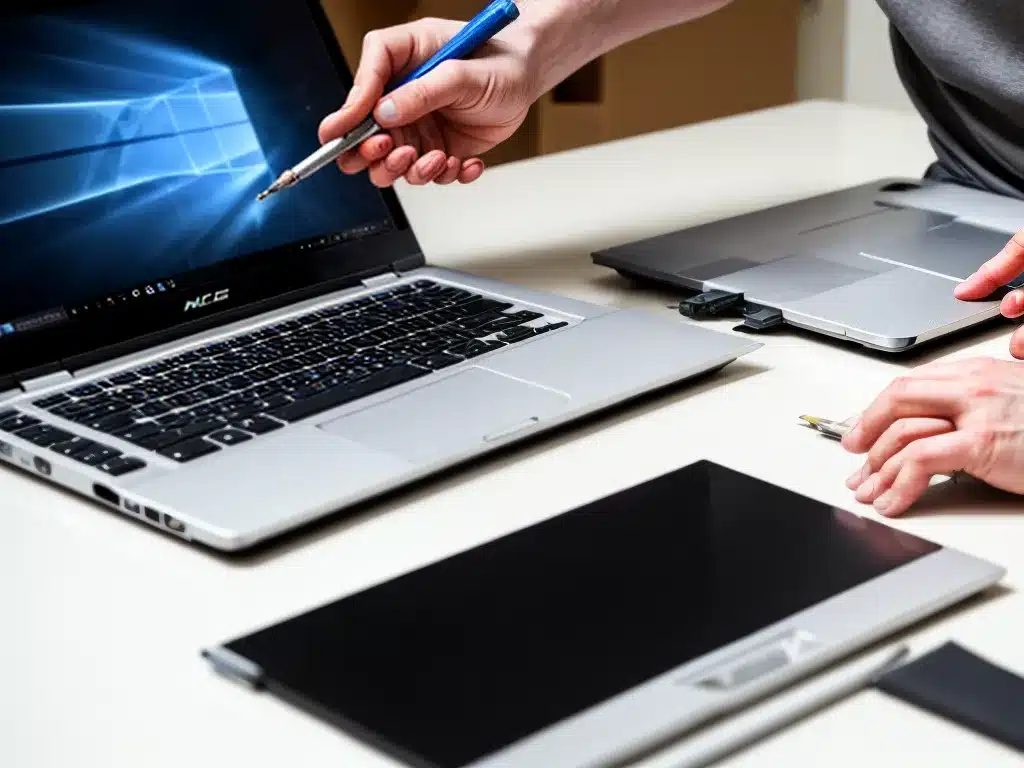
Introduction
Laptops are prone to physical damage from drops, spills, and other accidents. Repairing physical damage to laptops can range from simple DIY fixes to more complex repairs that require professional help. With some basic troubleshooting, you can assess the damage and determine if you can repair your laptop on your own or if you need to take it to a repair shop. This guide will walk you through the main types of physical damage to laptops and how to repair them.
Diagnosing the Damage
The first step is to diagnose what part of your laptop is damaged. Here are some of the most common types of physical damage:
Cracked Screen
If your display is cracked or broken, connect your laptop to an external monitor to see if the laptop itself is still functioning. Cracked screens can often be replaced as long as the laptop is operational.
Broken Ports
Inspect all the ports like USB, HDMI, charging port, etc. Damaged ports will need to be replaced.
Spilled Liquids
Dry out the laptop immediately if any liquid is spilled on it. Liquids can short circuit the motherboard and damage components. You may need to disassemble the laptop to clean or replace any affected parts.
Drops and Impacts
Dropping your laptop or impacts can damage internal components like the hard drive and motherboard. Diagnose by testing if the laptop powers on and all the components are functioning properly.
Broken Hinges
Check if the screen wobbles or the hinges are cracked. Broken hinges will need to be replaced.
Keycap or Keyboard Damage
Determine if any keycaps have popped off or if the keyboard itself is damaged. Keycaps can be popped back on but the keyboard may need replacement.
Repairing the Damage
Here are some tips on how to repair common types of physical laptop damage:
Cracked Screen Replacement
Replacing a cracked laptop screen requires disassembling the display bezel and removing the old screen. Install the new replacement screen, reconnect display cables, and reassemble the bezel.
Port Replacement
Damaged ports like USB or HDMI ports need to be desoldered and a new port must be soldered into place on the motherboard. This requires some soldering expertise.
Liquid Damage Repair
Disassemble the laptop to access the motherboard. Clean the motherboard with isopropyl alcohol and inspect for any corroded or damaged components. Replace any parts that got shorted out or damaged.
Structural Repairs
For drops, impacts, or broken hinges, the plastic casing or internal frame may need to be replaced. You can order replacement parts and follow repair guides to replace casings, hinges, or internal chassis frames.
Keyboard Replacement
For keyboard issues, the entire keyboard needs to be replaced most of the time. You can order a replacement keyboard and remove the old keyboard by taking apart the laptop.
When to Take It to a Repair Shop
If you don’t feel comfortable doing advanced repairs like soldering new ports or replacing internal components, take your laptop to a reputable repair shop. Repair shops have the expertise to diagnose issues and perform all the necessary repairs.
Data Backup Tips
Before attempting any DIY repairs on your laptop, make sure to backup your data. Some repairs like motherboard replacement can wipe your data. Back up to an external hard drive or cloud storage. You can use built-in Windows backup tools.
Summary
- Assess physical damage like cracked screens, liquid spills, broken ports, drops, or keyboard issues
- Determine if you can do DIY repairs like screen replacements
- More complex repairs like port soldering may need professional repair shops
- Backup important data before attempting repairs
- Order replacement parts for screens, keyboards, casings, hinges, etc
- Follow repair guides carefully for your specific laptop model
- Repairing physical damage can extend your laptop’s life at a lower cost than replacing it
With some basic repair skills and proper replacement parts, you can often repair common physical damage issues with laptops. Seek professional repair help for complex repairs beyond DIY fixes. Properly diagnosing issues and backing up data ahead of time is crucial before attempting repairs.












